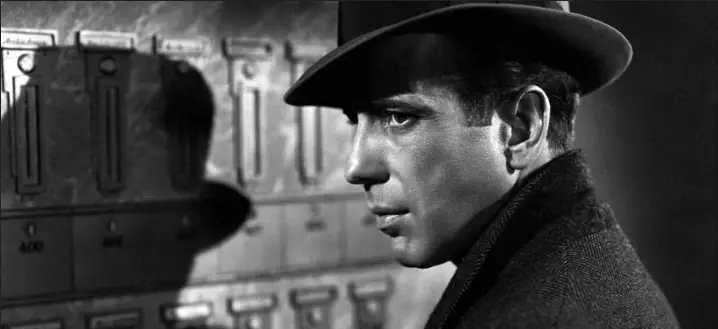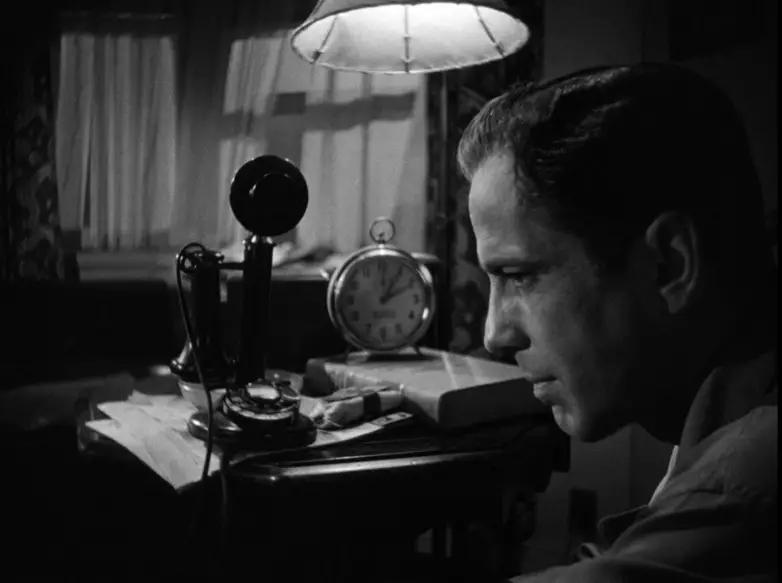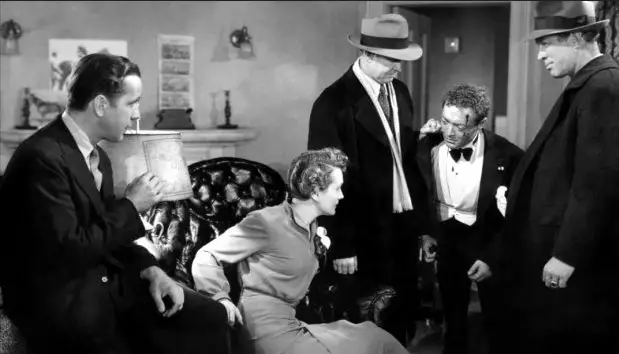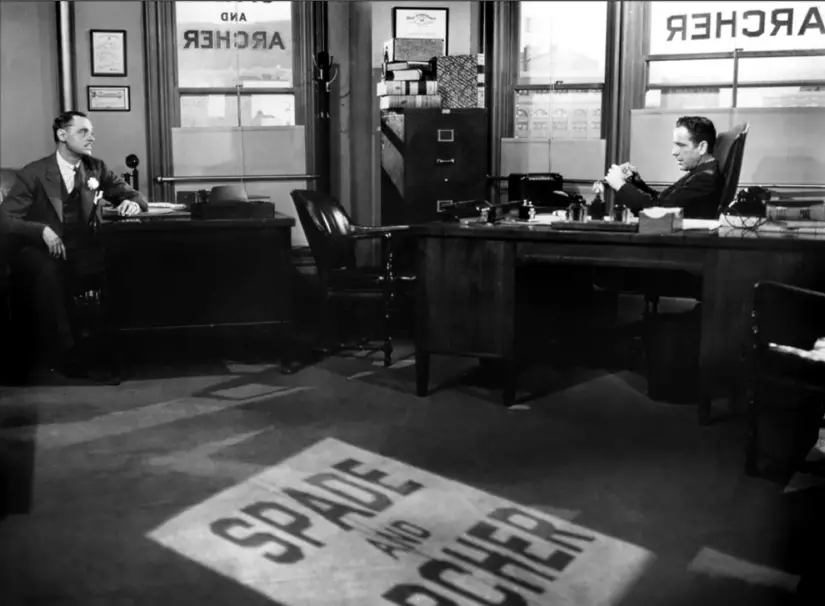
Director: John Huston
Producers: Henry Blake, Hal B. Wallis (First National, Warner Bros.)
Writers: Dashiell Hammett (novel), John Huston (screenplay)
Photography: Arthur Edeson
Music: Adolph Deutsch
Cast: Humphrey Bogart, Mary Astor, Peter Lorre, Sydney Greenstreet, Gladys George, Barton MacLane, Lee Patrick, Ward Bond, Jerome Cowan, Elisha Cook Jr., James Burke, Murray Alper
![]()
Introduction
In examining the impact of Humphrey Bogart, scholar David Thomson looks to the French New Wave masterpiece Breathless (1959), directed by Jean-Luc Godard and co-written by Francois Truffaut, in which lead actor Jean-Paul Belmondo first sighs the name “Bogie.” (A)
Such male fascination with Bogart is a telling time capsule of when the nostalgic romanticization of the actor first took effect. No doubt he was a superstar throughout the ’40s, from Casablanca (1942) to The Big Sleep (1946). But Bogart’s claim on legendary status took hold shortly after his death in 1957, when a whole new generation latched onto his work and has not yet let go.
That’s because “Bogie” is everything they want to be, a figure who demonstrates sure control and sound judgment in times of chaos, traits that would have come in handy in their own lives during the increasingly-chaotic ’60s and ’70s. Hence the adoration of guys like Woody Allen, who paid Bogart the ultimate respect in Play it Again, Sam (1972), where the protagonist has Bogart for an imaginary friend, one that gives him pointers on impressing the ladies with those classic hardboiled lines.
Of course, all of this had an origin, a moment when a streaking Hollywood comet could no longer be ignored, a moment that came in John Huston’s The Maltese Falcon (1941), when Bogart was cast as Dashiell Hammett’s famous detective Sam Spade. It’s important to remember that the source novel was written by Hammett in 1930, at the height of the Great Depression. Two screen adaptations pre-dated Bogie, first in 1931 with Bebe Daniels and Ricardo Cortez, then a looser-based version Satan Met a Lady (1936), starring Bette Davis and Warren William. But while Huston’s Maltese Falcon lacks an originality of story, it is entirely original in atmosphere, considered by many the birth of the film noir movement, establishing countless archetypes from the hard-boiled detective to the femme fatale. How fitting that the very term noir was coined by the same French that first sighed, “Ah, Bogie.”
![]()
Plot Summary
Sam Spade (Bogart) and Miles Archer (Jerome Cowan) are partners in the “Spade & Archer” private-eye service of San Francisco. Through the milky, opaque glass doors with stenciled text walks Brigid O’Shaughnessy (Mary Astor), a tight-haired, tight-suited femme fatale, who asks the boys to tail a man named Thursby. Little do they know the mess they’re stepping in. During his night shadowing of Thursby, Miles is shot dead, and before long, Spade discovers that Thursby, too, has been bumped off. Everyone’s a suspect, including Miles’ wife, Iva (Gladys George), who never liked her husband, and even Spade himself.
Nothing seems to fit until the arrival of Joel Cairo (Peter Lorre), a short, curly-haired weasel smelling like gardenia, who suggests the murders may have something to do with the quest for a rare bird statue, known as The Maltese Falcon. According to legend, in 1539, the Knights Templar of Malta sent a Golden Falcon, encrusted with jewels and disguised in black enamel, as a gift to Charles V of Spain, only the exchange was ransacked by pirates and the bird lost for centuries. Now it seems this elusive treasure has finally resurfaced, passing in and out of the hands of several searchers.
Cairo offers Spade $5,000 for the bird’s retrieval, which Spade accepts, believing it will lead to Miles’ killer. His journey gets him mixed up with a motley crew of Falcon-seekers, including the persistent Cairo, the grossly overweight crook Kasper “Fat Man” Gutman (Sydney Greenstreet), his frustrated henchman Wilmer Cook (Elisha Cook Jr.) and O’Shaughnessy herself, with whom Spade admits he has fallen in love. But when love and duty collide in an archetypal noir world where “everyone has something to conceal,” first impressions are cheap and the choices aren’t always easy.
![]()
Noir Typewriter Gold
As one of the best detective movie sever made, the strength of The Maltese Falcon lies in its script, voted #47 on the WGA’s Top 101 Screenplays. Though Huston was himself a talented screenwriter, he admittedly had very little adapting to do because Hammett’s novel was so good. The complex, twisting plot was sufficiently compelling, packed with shock moments (#26 AFI Thrills) in an overall puzzle where the pieces gradually fall into place (#6 AFI Mysteries).
In addition to the plot, Hammett’s dialogue was so good that Huston copied it almost verbatim — “Keep on riding me and they’re gonna be picking iron out of your liver;” “You know, that’s good, because if you actually were as innocent as you pretend to be, we’d never get anywhere;” “If you’re a good girl, you’ll be out in 20 years, I’ll be waiting for you. If they hang you, I’ll always remember you;” and the hilariously blunt, “When you’re slapped, you’ll take it and like it.”
The excellence flows all the way to the famous last line of the film (#14 AFI Movie Quotes), where a fellow cop (Ward Bond, Bert the Cop in It’s a Wonderful Life) asks Bogart what exactly the Maltese Falcon is, drawing that legendary response, “The, uh, stuff that dreams are made of,” voted #14 all-time on the AFI’s 100 Movie Quotes.
![]()
The Stuff That Casting is Made Of
With the script practically self-written, Huston pre-production priority was the casting. Needless to say, he nailed it perfectly. In choosing Bogart, he found the perfect match between actor and character. Premiere magazine recently voted Sam Spade the #80 Greatest Movie Character of All Time, and likewise voted Bogart’s performance the #50 Greatest of All Time. The two are inextricably linked — that tan fedora with the black stripe above the brim and the black suit and tie, often covered in a belted trench coat. As for Spade’s demeanor, the Fat Man says it best: “You are a character. You never know what you’ll do or say next.”
Indeed, Spade is always ready with a pet name (“Angel”) or smart response (“You’re not gonna go around the room straightening things again, are you?”). He’s a consummate professional, fearless and quick to knock a gun out of a villain’s hand. Most importantly, he’s not the least bit gullible, listening to a far-fetched story while staring at the person in amusement: “You’re good. You’re very good.” The reason we respect Spade so much is because, in the end, he does the right thing, despite his heart tugging in the other direction. Such a character was a big break from tradition for Bogart, who got his start playing B-gangster villains in movies like The Petrified Forest (1936) and Angels With Dirty Faces (1938). The Maltese Falcon flipped the switch, and moviegoers came out in spades — Sam Spades.

As for the faces around him, it remains one of the finest supporting casts in movie history. Mary Astor, of the famous Astor family, is at her career best as the femme fatale who’s “tired of lying.” To quote Spade, Astor’s biggest strength is “her eyes and the throb she gets in her voice.” She is both suspicious and endearing, a concoction that has us feeling exactly as Spade does in his moment of choice.
But if any of the supporting actors deserve credit, it’s the dynamic duo of Peter Lorre and Sydney Greenstreet. Appearing in his first “talkie,” Greenstreet made his villain so lovably amused that he earned an Oscar nomination. As for Lorre, he was born to play this ratty role, having already cut his teeth as the villainous pedophile in Fritz Lang’s German masterpiece M (1931) and a pair of British Hitchcock flicks, The Man Who Knew Too Much (1934) and The Secret Agent (1936). While Greenstreet is arguably the more memorable, for his sheer size alone, it’s Lorre who has enjoyed perhaps the greater cult following of any classic character actor. Together, they are what critic Kim Newman called “The Laurel and Hardy of crime,” so good that they were both asked to return with Bogart the following year in Casablanca. (B)
![]()
Huston, We Have a Director
Corralling all of these brilliant actors, and seeing that the script is executed on screen, was writer/director John Huston, in his directorial debut. If you set out to chronicle Bogart’s rise to stardom, you’ll quickly find that you’re also chronicling the rise of Huston. A screenwriter throughout the ’30s, Huston got his first big break writing the script for Raoul Walsh’s High Sierra (1941), co-starring Bogart and future female filmmaker Ida Lupino. This success opened the door to The Maltese Falcon, the first of six Huston directed for Bogart, including The Treasure of the Sierra Madre (1948), Key Largo (1948) and The African Queen (1951), which finally won Bogart the Oscar. Huston’s claims he took his first stab at directing seriously:
“The best piece of advice that was ever given to me [was] by Henry Blake when I was about to make “The Maltese Falcon.” He said each shot you do should be the most important shot. If it’s somebody getting out of a car, he must get out of that car perfectly. The camera should be in the right place when he gets out. The car should approach the curb at exactly the right angle. Everything should be perfect. Your entire attention and concentration should be on the shot you are doing at this particular swift instant in time. … I didn’t want to be a fool on my first picture … so I made drawings of the setups in each scene. I discovered when I went to shoot the picture that about 50% of the time when I’d have the actors rehearse a scene, they would fall into the positions I had drawn out.“ (C)

Unlike some of history’s more in-your-face filmmakers (Welles, Scorsese, Tarantino), Huston wanted to achieve an air of invisibility in his direction, but which upon further review, would reveal a dazzling display of artistry:
“These shots are almost ballet — the camera is dancing with the actors and the scene. These are never noticed if they are good. The audience sees them but never realizes what’s happening. There are scenes like this in The Treasure of the Sierra Madre and The Maltese Falcon. I remember one scene that was marked out by the cameraman where there were 26 marks. The camera moved, dollied, crabbed and so on. There can be as many as that, and the audience never knew it was happening. No critic has ever commented on this scene.” (C)
Unfortunately, it took a few years for Huston to truly master his craft. Scholar David Thomson called Maltese a “striking debut” but “clumsy with its direction.” (A) Still, it’s a strong first effort, with countless images sticking with viewers. The Spade/Archer floor window shadow was an image twice used by director Michael Curtiz, first with the “Cohan/Harris” letters of Yankee Doodle Dandy (1942), then with the “La Bell Aurore” in Casablanca (1942).

Note also Huston’s shot of Lorre removing the false bottom of his umbrella in the bottom left corner of the frame; the low-angled shots making The Fat Man look all the more bloated; the montage of subjective shots, showing that Wilmer knows he’s screwed; and the genius final image of the elevator door closing on the guilty party like jail bars, the shadow forming a “falcon foot” around a single eye, like the fatalistically flawed iris of Faye Dunaway’s femme fatale in Roman Polanski’s Chinatown (1974), starring who else but John Huston as the villain.

![]()
Legacy
Polanski’s use of Huston in his own neo-noir masterpiece speaks volumes to the impact of The Maltese Falcon. If you’ve never seen the movie, you’ve likely still heard the title due to any number of pop culture references, like ABC’s Whose Line is it Anyway?, where host Drew Carey applied a noir scenario to one of the improvisation games called The Maltese Burger. And in 2007, the American Film Institute ranked The Maltese Falcon #31 on its Top 100 Movies of All Time, a slight drop from its #23 spot a decade earlier, but a strong showing nonetheless.
The film remains a unanimous classic among the critics, carrying a 100% on Rotten Tomatoes, while featuring enough biting one-liners to woo mainstream audiences, who voted it an 8.2. on IMDB. Still, perhaps the greatest testament came in 2013, when the actual prop statue of the falcon was auctioned for $4 million, proving it’s still the stuff that dreams are made of.
![]()
Citations:
CITE A: David Thomson, New Biographical Dictionary of Film
CITE B: 1001 Movies You Must See Before You Die
CITE C: George Stevens Jr, Conversations with the Great Moviemakers of Hollywood’s Golden Age
